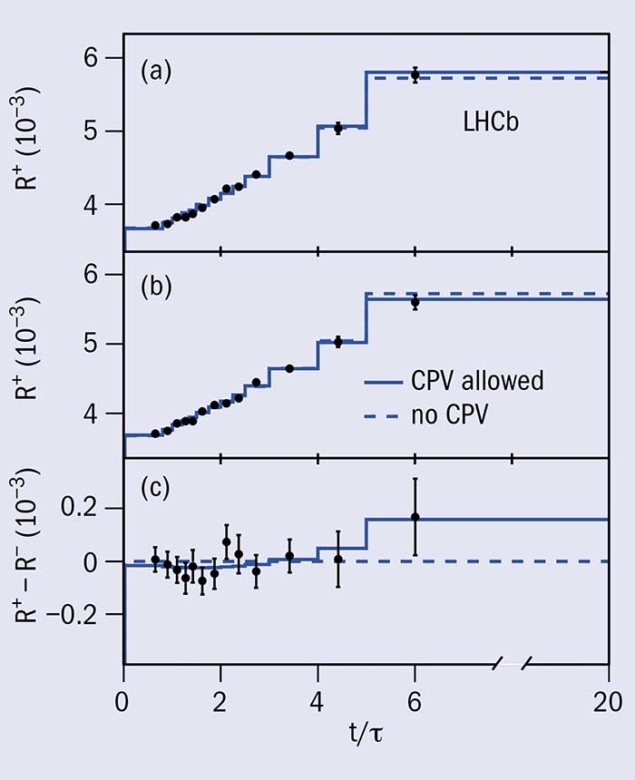
Direct searches for particles beyond the Standard Model (SM) have so far come up empty handed, but perhaps physicists can get luckier with indirect searches. Quantum mechanics allows neutral flavoured mesons to transform (or oscillate) into their anti-meson counterparts and back via weak interactions. Novel particles may contribute to the amplitude that governs such oscillations, thus altering their rate or introducing charge-parity (CP) violating rate differences between mesons and anti-mesons. Depending on the flavour structure of what lies beyond the SM, precision studies of such effects can probe energies up to 105 TeV – far beyond the reach of direct searches at the maximum energy currently achievable at colliders.
Oscillations, first posited in 1954 by Gell-Mann and Pais, have been measured precisely for kaons and beauty mesons. But there is room for improvement for D mesons, which contain a charm quark. Neither a nonzero value for the mass difference between mass eigenstates of neutral D mesons, nor a departure from CP symmetry, have yet been established. Charm oscillations are especially attractive because the D-meson flavour is carried by an up-type (i.e. with an electric charge of +2/3) quark. Charm-meson oscillations therefore probe phenomena complementary to those probed by strange- and beauty-meson oscillations.
LHCb recently determined charm- oscillation parameters using 5 fb–1 of proton–proton collision data collected at the LHC in 2011–2016. About 5–10% of LHC collisions produce charm mesons; approximately 10,000 per second are reconstructable. Oscillations are studied by comparing production and decay flavour (i.e. whether a charm or an anti-charm is present) as a function of decay time. The charge of the pion from the strong-interaction decay D*+ → D0 π+ determines the flavour at production. The decay flavour is inferred by restricting to K±π∓ final states because charm (anti-charm) neutral mesons predominantly decay into so-called right-sign K–π+ (K+π–) pairs. Hence, a decay-time modulation of the wrong-sign yields of D0 → K–π+ and D0 → K+π– decays indicates oscillations. In addition, differing modulations between charm or anti-charm mesons indicate CP violation. Backgrounds and instrumental effects that induce a decay-time dependence in the wrong-sign yield, or a difference between charm and anti-charm rates, may introduce harmful biases.
LHCb used track-quality, particle identification, and D0 and D*+ invariant masses to isolate a prominent signal of 0.7 million wrong-sign decays overlapping a smooth background. Decays of mesons produced as charm or anti-charm were analysed independently. The wrong-sign yield as a function of decay time was fitted to determine the oscillation parameters. Statistical uncertainties dominate the precision. Systematic effects include biases from signal candidates originated from beauty hadrons, residual peaking backgrounds, and instrumental asymmetries associated with differing K+π– and K–π+ reconstruction efficiencies. With about 10–4–10–5 absolute (10% fractional) precision, the results are twice as precise as the previous best results (also by LHCb) and show no evidence of CP violation in charm oscillations.
Further reading
LHCb Collaboration 2018 Phys. Rev. D 97 031101.







